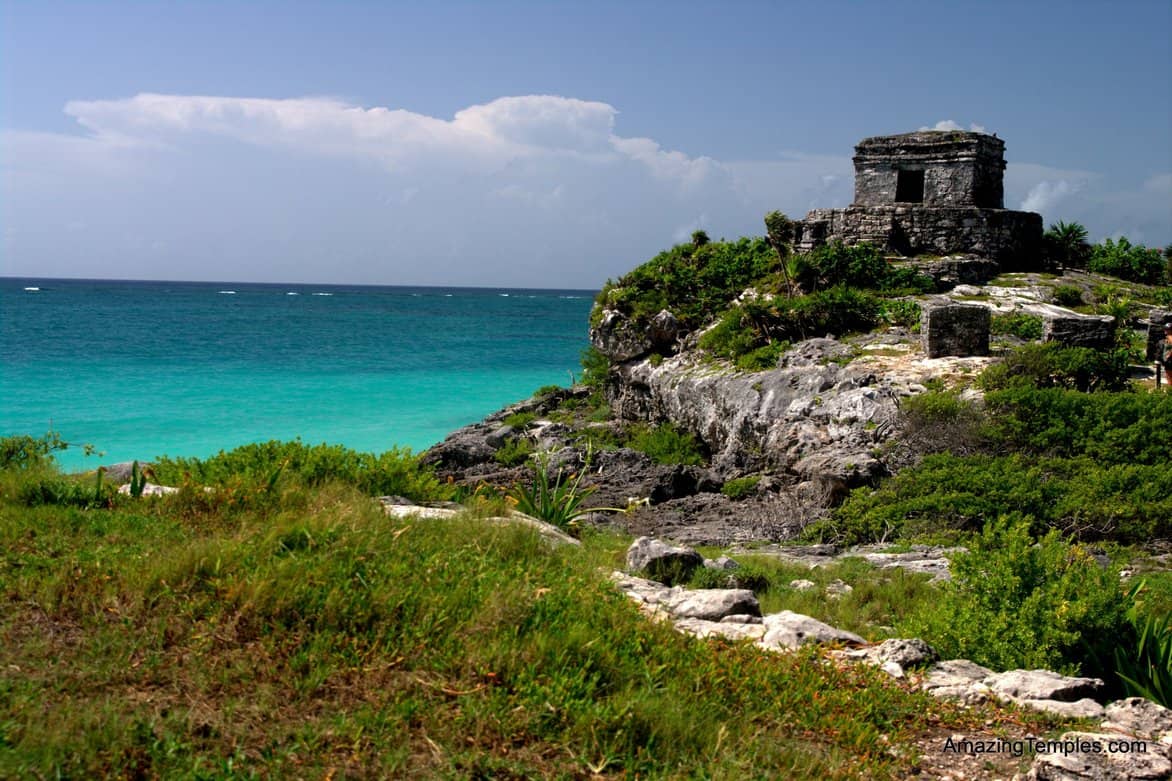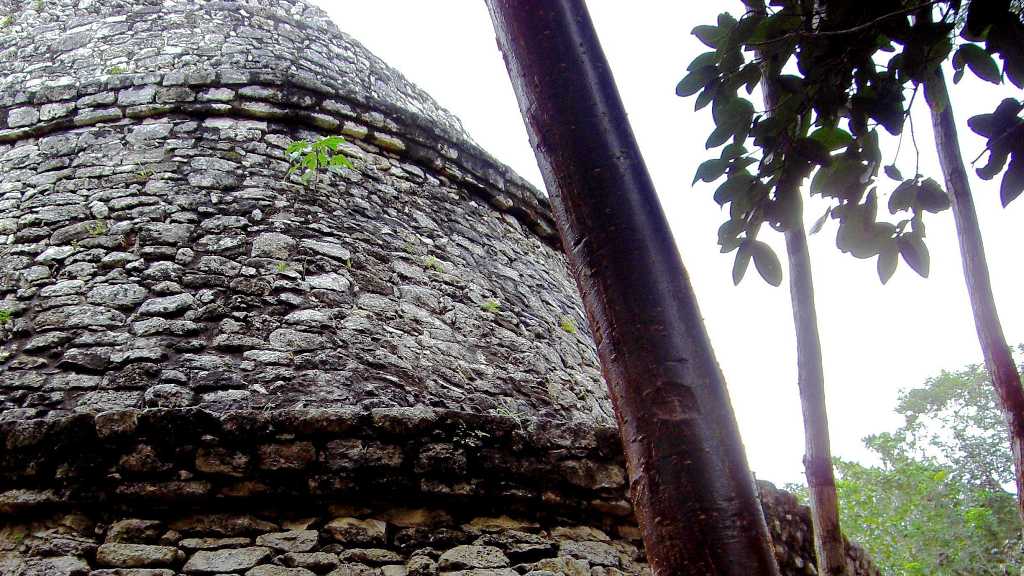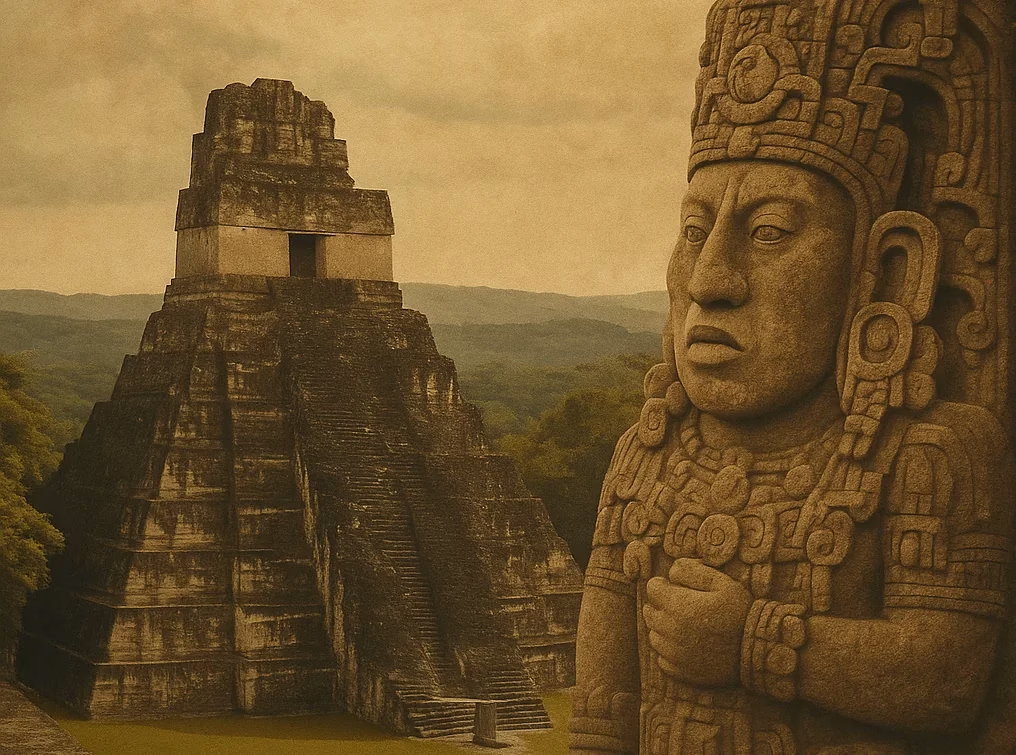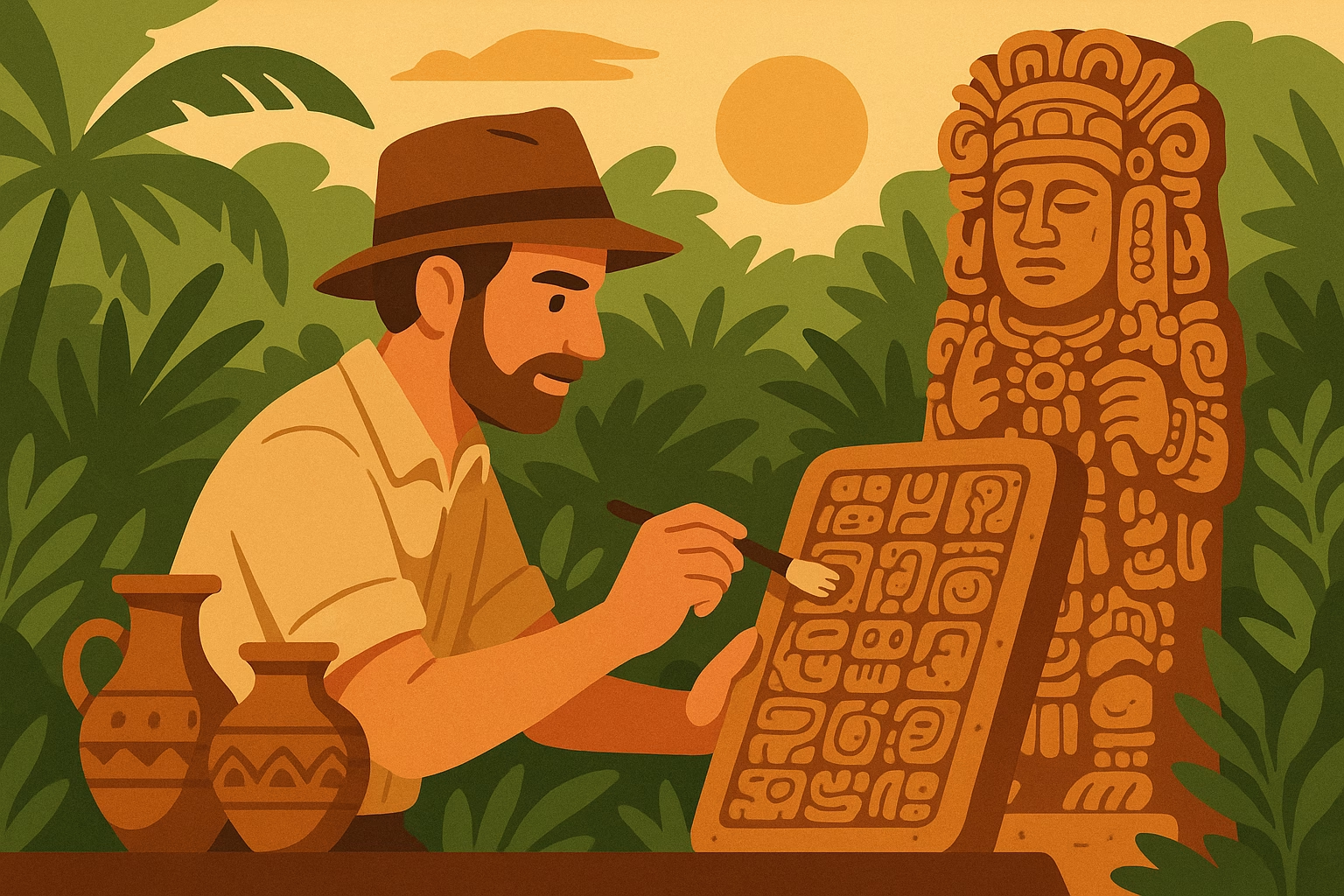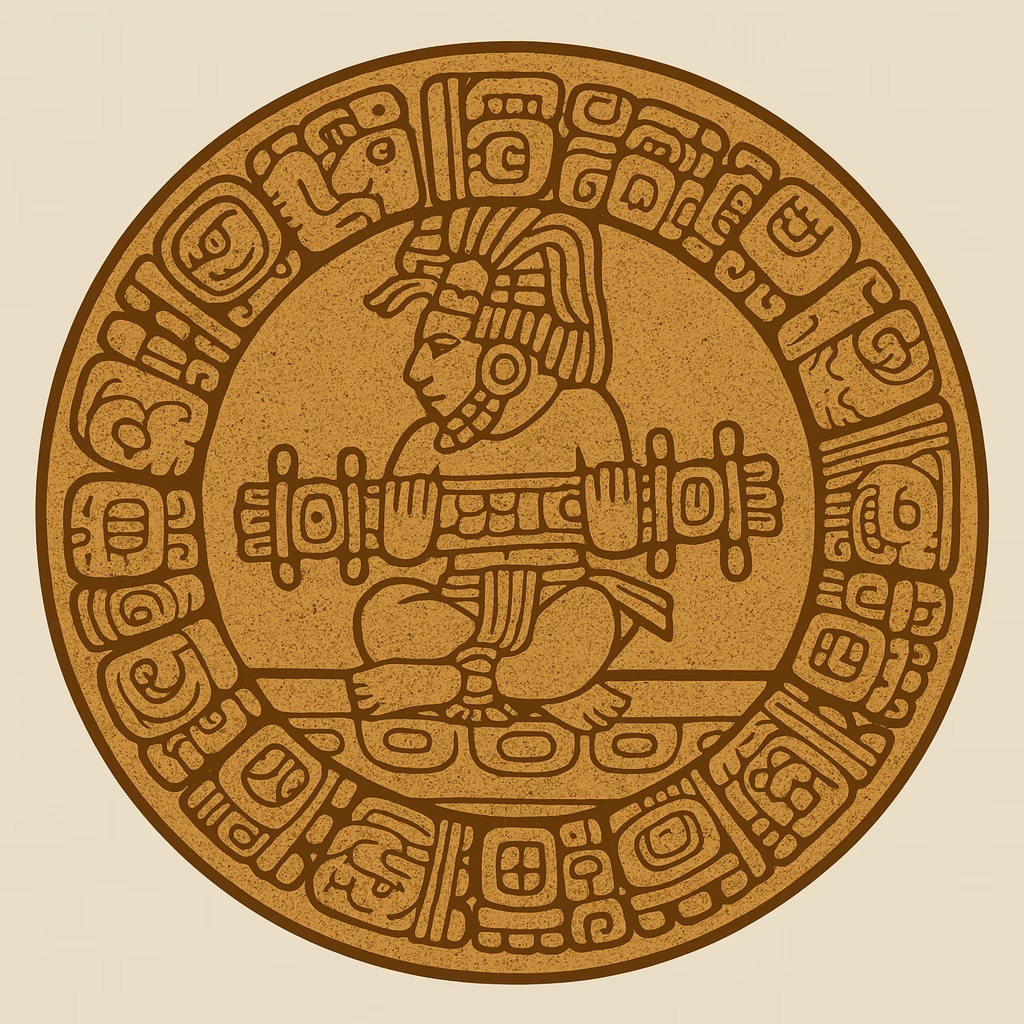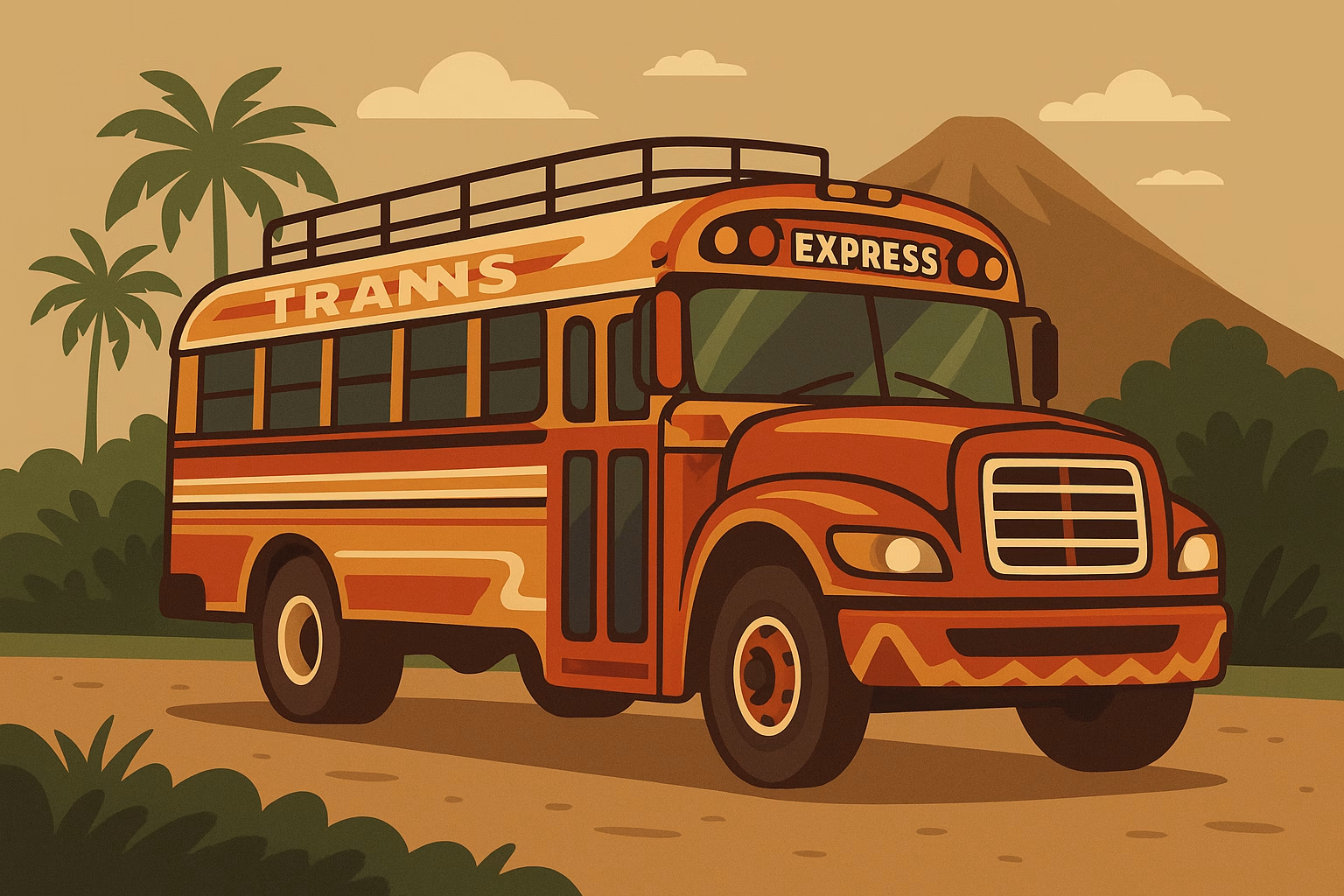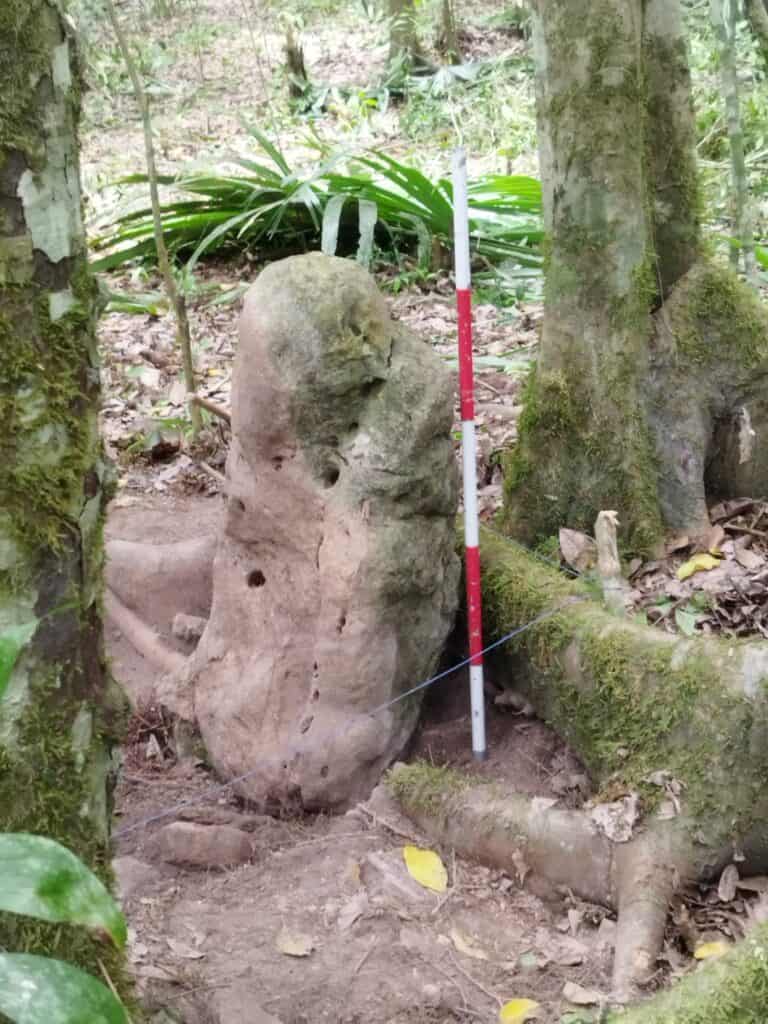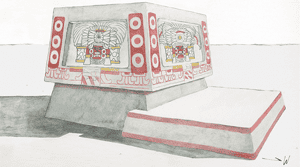Copán – 400 Years of Dynasty, 2,200 Glyphs, and Cutting-Edge Research
Copán – Where Stone Chronicles Come Alive
As you descend the last curves of Ruta CA-11, an emerald-green valley suddenly unfolds. Morning mist drifts over cornfields, while the hoarse squawks of scarlet macaws mingle with the steady chirping of cicadas in the distance. Copán, Maya Oxwitik—”Three Witik”—sprawls like an oversized chessboard of temple stumps, stelae, and grassy plazas in this oasis. That this was once a thriving intellectual center of the classical Maya world only becomes clear to visitors when they learn to read the stone insignia: 2,200 glyphs, 17 kings, 400 years of world order—chiseled in basalt and limestone.
Copán is not just an archaeological site but a multi-layered experience: a time capsule of human creativity, a laboratory for high-tech research, and a nature sanctuary where parrots and bromeliads compete in brilliance. In this guide, we take you on a journey from the first cornfields to the 2025 laser scans—through electrically lit tunnels and state-of-the-art muon tomography.
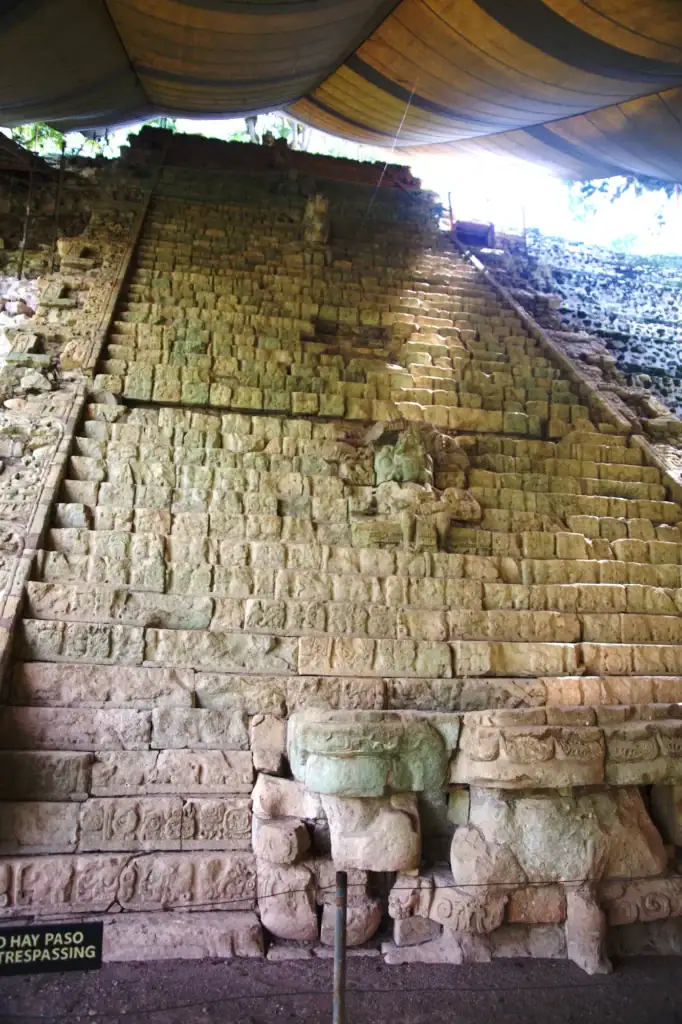
Timeline – From Cornfield to Metropolis
As early as 1500 BCE, farming families settled in the valley, drawn by volcanic soils and a climate allowing two harvests per year. What began as scattered settlements transformed over two millennia into a highly structured city. In 426 CE, Copán’s great hour arrived: Kʼinich Yax Kʼukʼ Moʼ—according to the glyphs—arrived wearing Teotihuacán’s feathered headdress and established a new dynasty. From this moment, the city reads like an epoxy resin cast of its rulers: every construction phase, every stelae forest, even every stair step marks a sequence of dynastic rhythms.
In the year AD 738, a dramatic turning point occurred in the history of Copán. Tensions between Copán, ruled by Uaxaclajuun Ubʼaah Kʼawiil (18-Rabbit), and its former vassal city Quiriguá escalated into open conflict. K’ak’ Tiliw Chan Yopaat, the ruler of Quiriguá, captured and executed the Copán king—an event vividly documented in numerous glyphic inscriptions. Losing their ruler and control over critical trade routes plunged Copán into a prolonged decline. Quiriguá, on the other hand, flourished after this victory, consolidating its independence and significantly increasing its economic and political influence.
| Phase | Time | Highlights |
|---|---|---|
| Early Settlement | from 1500 BCE | first ceramics, scattered settlements |
| Dynasty Founding | 426 CE | Kʼinich Yax Kʼukʼ Moʼ establishes the lineage |
| Golden Age | 695 – 738 | Waxaklajuun Ub’aah K’awiil (18-Rabbit) erects Stelae A–N & Ballcourt III |
| Crisis | 738 | 18-Rabbit beheaded by Quiriguá; trade routes collapse |
| Renewal | 749 – 763 | Kʼakʼ Yipyaj Chan Kʼawiil doubles the Hieroglyphic Stairway |
| Late Phase | 763 – 822 | Yax Pasaj Chan Yopaat completes Altar Q; inscriptions fall silent in 822 |
| Abandonment | 9th–10th c. | population collapses, center decays |
To feel the silence of the decaying plaza, sit for a moment at the central four-way crossroads. Between raspberry-red ant highways and the distant melody of a marimba radio, it becomes clear: world politics once unfolded here.
Dynastic Drama – 17 Rulers in 400 Years
Copán’s ancestral gallery is astonishingly vivid. On Altar Q, the first 16 kings sit like chess pieces in half-profile, while the 17th—Ukit Tookʼ—is only known in fragments. Royal names like Smoke Imix or Kʼakʼ Yipyaj Chan Kʼawiil sound poetic, yet they conceal hard-nosed power politics. Through marriages with Palenque, tribute secured from Quiriguá, or synchronized calendar entries, rulers sought to embed their valley into Mesoamerica’s dense urban network.
Fun Fact: Researchers from Delaware detected strontium levels in dynasty founder Yax Kʼukʼ Moʼ’s bones that don’t match Copán’s surroundings. Evidently, he came “from beyond the sea,” as legend claims—from Central Mexico’s highlands, but more likely from Petén or even Caracol in Belize.

Overview
| No. | Ruler Name / Epithet | Reign | Notable Events & Projects |
|---|---|---|---|
| 1 | Kʼinich Yax Kʼukʼ Moʼ | 426–437 | Dynasty founder; strontium suggests origin from Petén, possibly Caracol (Belize); built first Acropolis courtyard; appears on Altar Q in Teotihuacán attire. |
| 2 | Kʼinich Popol Hol | ca. 437–455 | Founder’s son; built Ballcourt I; earliest phases of Temple 26; honored father with rich burial under Temple 16. |
| 3 | Ruler 3 (name eroded) | 455–ca. 465 | Transition era; mentioned on Altar Q; likely completed courtyard buildings and minor Río Copán bridges. |
| 4 | Kʼaltuun Hix | ca. 465–476 | Documented by Stela 64 (2024 find); stabilized trade networks, introduced cacao taxes in Motagua Valley; secured dynastic succession. |
| 5 | Ruler 5 (name eroded) | late 5th c. | Epigraphically elusive; consolidated agriculture via new irrigation channels; few monuments preserved. |
| 6 | Ruler 6 (name unknown) | late 5th c. | Initiated early courtyard expansion; evidence fragmentarily in Hieroglyphic Stairway; early classical construction. |
| 7 | Bʼalam Nehn (Waterlily Jaguar) | ≤504–544 ? | First stelae with dynastic counts; diplomatic ties to Caracol (Belize); began underground drainage system. |
| 8 | Wil Ohl Kʼinich | ca. 544–551 | Short reign; adorned Temple 16 roof combs with wing symbolism; set new standards for courtyard reliefs. |
| 9 | Sak-Luʼ (Moon Jaguar) | 551–553 ? | Continued court programs; likely repainted east plaza with ocher pigment; militarily quiet phase. |
| 10 | Tziʼ-Bʼalam | 553–578 | Probable builder of Audience Hall 10L-11; fortified riverbanks with basalt blocks; donated jade buttons to allied cities. |
| 11 | Kʼakʼ Chan Yopaat | 578–628 | 49-year peaceful reign; population explodes; founded satellite sites like Río Amarillo; began formal market regulations. |
| 12 | Smoke Imix (Kʼakʼ Uʼx Witʼ Kʼawiil) | 628–695 | Longest reign (67 yrs); first version of Hieroglyphic Stairway; built astronomy platform for zenith sun observations. |
| 13 | Uaxaclajuun Ubʼaah Kʼawiil (18-Rabbit) | 695–738 | Golden Age: Stelae A–N, Ballcourt III with macaw sculptures; promoted sculptor schools; ended tragically with beheading in Quiriguá. |
| 14 | Kʼakʼ Joplaj Chan Kʼawiil (Smoke Shell) | 738–749 | Ruled under Quiriguá crisis; built emergency dikes against river erosion; few new monuments but stabilized administration. |
| 15 | Kʼakʼ Yipyaj Chan Kʼawiil | 749–763 | Renaissance phase: doubled Hieroglyphic Stairway (Version 2); erected Stela M; renewed state rituals focused on ancestor worship. |
| 16 | Yax Pasaj Chan Yopaat | 763–799/810 ? | Son of Palenque princess; completed Altar Q & Temple 11; initiated Acropolis tunnels to honor older shrines; diplomatic missions to Palenque. |
| 17 | Ukit Tookʼ (contested) | 822 (briefly) | Began Altar L; inscriptions abruptly silenced; marks onset of rapid collapse. |
Note: Rulers 3–10 names fragmentary; transcriptions follow Stuart & Fash 2024.
Architectural Highlights – Copying Encouraged, Amazement Guaranteed
Acropolis & Rosalila Temple
Imagine an onion tower of stone: ten temple layers stacked, each generation adding a new facade without demolishing the old. The Acropolis is precisely that—a timelapse in stone. Deep within rests Rosalila Temple (571 CE), discovered in 1993, perfectly preserved like a comic book panel cast in stucco. Its still pink-violet facade shows masks of the mountain god, once wreathed in incense smoke vented through narrow channels. Archaeologist Patricia Castillo described entering Rosalila as a “time machine with sandalwood perfume.”
Hieroglyphic Stairway – Longest Maya “Book”
62 steps, each a paragraph, each with double-column text. If laid end-to-end, the glyph blocks form a 30-meter stone tablet. The text narrates 400 dynastic years like a royal soap opera—coronation rites, blood sacrifices, diplomatic journeys. The statues perched every twelve steps are famous: personified rulers, once brightly painted. Today, a 3D digital twin (2023–25) corrects the Carnegie reconstruction errors. Try the VR simulation at the Museo Regional to watch missing fragments slot into place like Tetris blocks.
Macaw skull at the ballcourt
Macaw skull at the ballcourt
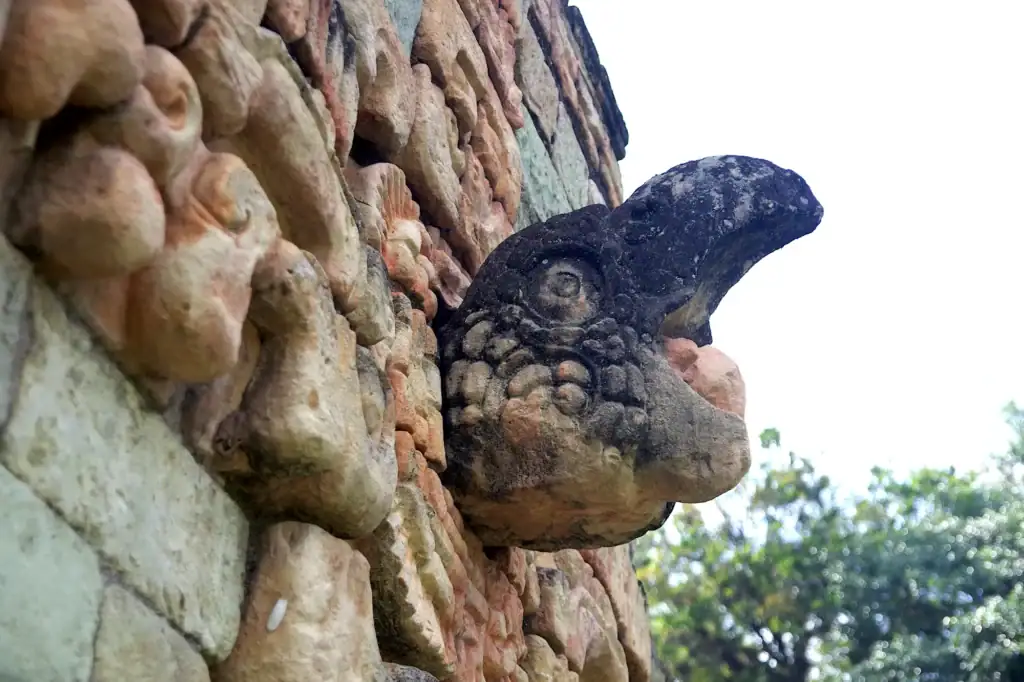
Great Plaza & Ballcourt III
The Great Plaza feels like an open-air sculpture park. Kapok trees frame Stelae A to N—exquisitely detailed portraits whose deep reliefs earned Copán the nickname “Paris of the Maya.” Behind it lies Ballcourt III. Its slanted walls feature macaw heads once inlaid with jade. The scoring markers bear the date January 6, 738—a day ending in disaster for 18-Rabbit.
Close your eyes: imagine a heavy rubber ball of vulcanized latex thudding in the noon heat, releasing warm latex’s signature scent—sulfurous, resinous, and earthy. Two teams in feathered regalia battled not for points, but cosmic balance. Winners and losers remain hotly debated.
Tombs – Windows to the Underworld
The Two “Key Tombs”
Hunal Tomb (under Temple 16, Hunal phase)
- Discovered 1995 by Sharer & Sedat.
- Dated 435–437 CE; burial of dynasty founder K’inich Yax K’uk’ Mo’.
- Findings: vaulted chamber with 60-year-old male skeleton, rich jade jewelry, Teotihuacán-style shell helmet, bone injury traces. Isotopes confirm origin outside Copán Valley (likely Petén/Tikal).
Motmot Tomb (under Structure 10L-26, Motmot phase)
- Cylindrical chamber sealed by the “Motmot Marker” (Long Count 9.0.0.0.0 = 435 CE).
- Main burial: seated young woman; offerings include sacrificed deer & puma, three male skulls, jade, mercury, feathers, 40+ ceramics.
- Popular guides sometimes misname it “Hunahpu Tomb”; academically correct is “Motmot.”
Other Significant Copán Tombs
| Tomb | Location & Date | Profile |
|---|---|---|
| Margarita | Above Hunal, Temple 16; ca. 440–450 CE | Multi-chamber burial of elite woman (“Lady in Red”); >2,000 objects (pyrite mirrors, jade, cinnabar). |
| Yehnal | Between Hunal & Margarita; ca. 450 CE | Platform with sun god masks; likely K’inich Popol Hol (Ruler 2); partially excavated. |
| Oropéndola | Inside Temple 16, found 2009 | Early 6th c. royal tomb; rich jade necklace (monkey-head pendant), jaguar pelts; identity debated (Ruler 7/8?). |
| Papagayo | Structure 10L-26 phase; mid-5th c. | Small chamber with death bundle, animal sacrifices, ballgame relics; possibly Ruler 4 Ku Ix. |
| Chorcha | Late Temple 26 phase; ca. 650 CE | Vaulted crypt: adult male + sacrificed child, 44 ceramics & 12 incense holders depicting 12 kings—candidate for Smoke Imix (Ruler 12). |
| Margarita successor “Oropéndola Lady” | Temple 16, secondary burial (7th c.) | Likely late-phase queen; unpublished, first reports 2024. |
2025 Research Update:
Muon tomography in the West Courtyard detects voids under Temple 11—suspected location of Ruler 15 K’ak’ Yipyaj Chan K’awiil’s tomb; initial results expected 2026.
Copán now has at least seven published royal/elite tombs. Hunal and Motmot mark the dynastic dawn; Margarita & Yehnal the founder’s circle; Oropéndola, Papagayo and Chorcha document the mid-to-late florescence—a unique continuum from the 5th to 7th century.
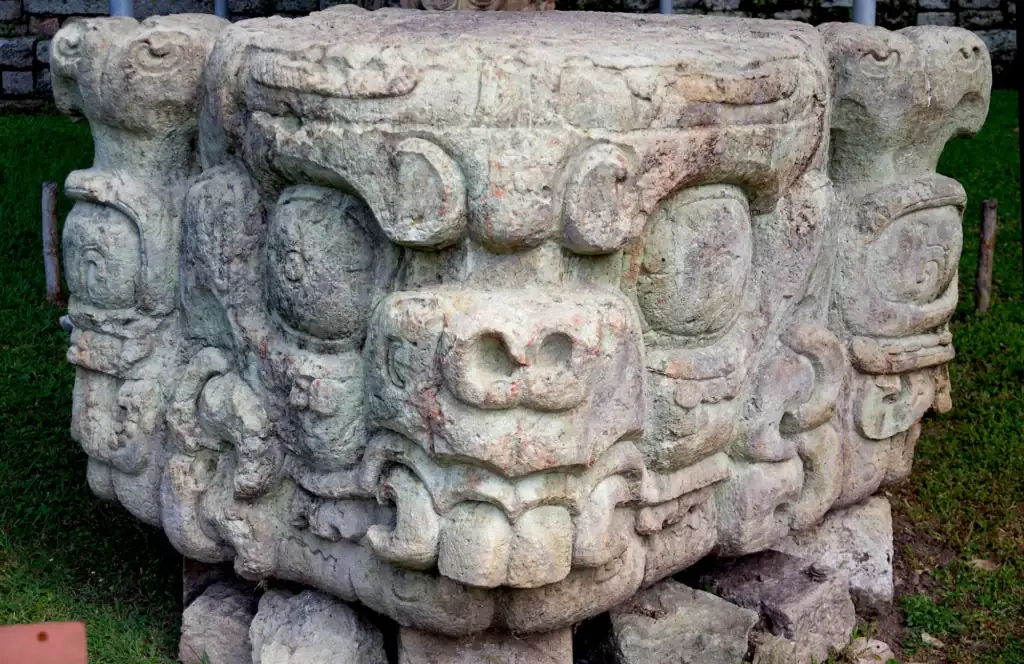
Research History – From Quill to Particle Physics
In 1576, Spanish judge Diego García de Palacio noted walls; in 1839, Stephens & Catherwood brought Copán to European salons via engravings. Science arrived on mules. Today, Nagoya University’s muon detectors blink in tunnels, sensitive enough to measure limestone density variations—X-rays without drills. Initial results (expected 2026) may detect unopened royal tombs.
Simultaneously, the Copán Digital Twin Project digitizes every glyph fragment, creating a virtual toolkit for global researchers to rearrange in real time. After nearly 100 years, this ends speculation about the Hieroglyphic Stairway’s original sequence.
2024/25 Updates – Copán in Real Time
- Archaeology: Stela 64 (March 2024) provides the valley’s oldest Long Count date (July 7, 465) and fills a dynastic gap.
- High-Tech: Muon detectors hunt two suspected royal tombs under Temple 11 since Dec 2024; results published 2026.
- Conservation: Japan-funded post-Hurricane (ETA/Iota) program installed drainage/backup power (2025) against tropical downpours.
- Museums: Museo Regional launched a VR flight over the Hieroglyphic Stairway (Sept 2024). A replica of “Hombre de Copán” debuted at UN HQ, New York (May 2025).
- Biodiversity: 43 active scarlet macaw nests—record since reintroduction began.
Visiting Tips – Make Your Trip Legendary
Best season: December–April (minimal rain, clear skies). For macaw courtship, visit February.
Getting there:
- Heads-up: Travel advisories exist for Guatemala/Honduras border zones. Check safety before travelling there
- Buses/tours run from Antigua, Guatemala City, or San Pedro Sula. Some from San Salvador.
- Personal route (2024): Rio Dulce → El Florido border (multiple bus changes, 10 hrs driving, no tourists) → collectivo to Copán
The Ruins:
- 30-min walk from Copán town.
- Hours: 8:00–16:00 daily. Main site $15, tunnels $15 (separate ticket!).
- Photo tip: 9:00 AM light under stairway canopy creates perfect glyph shadows.
- Time needed: 2–3 hrs site + 1 hr sculpture museum; archaeology nerds need a full day.
- Extras: Macaw Mountain bird park (10-min tuk-tuk) has free-flying macaws + swimming waterfall.
- Local insider: Try Sopa de Caracol (conch coconut soup)—as rich as the stairway’s iconography.
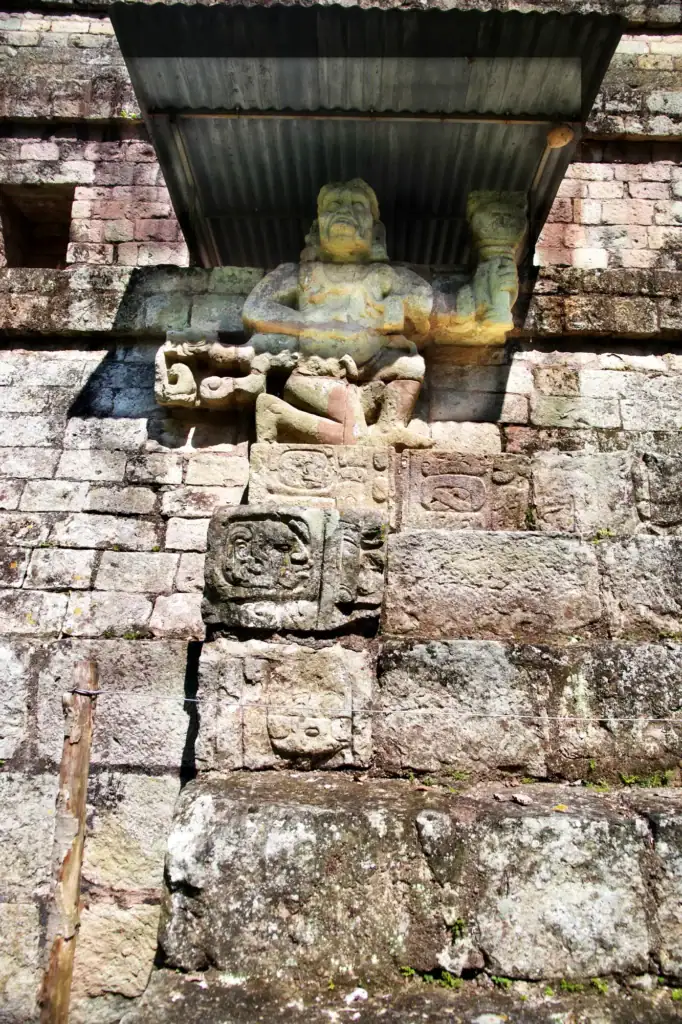
FAQ – Copán’s Most Common Questions
How do I reach Copán Ruinas easiest?
From San Pedro Sula: Comfortable buses (Hedman Alas, Viana; 3.5 hrs). From Guatemala City: Direct via Chiquimula (~6 hrs). Rental car: ~180 km via CA-11.
Do I need a guide?
Signage is bilingual (Spanish/English). Local guides (~$25/2 hrs) offer insights and access to lesser-known zones like Las Sepulturas.
Are underground tunnels open?
Yes, two main tunnels (Rosalila & Los Jaguares) accessible with extra ticket ($15). Helmets provided; guide mandatory.
Safety concerns?
Copán Ruinas is among Honduras’ safest towns. Still: avoid night walks, secure valuables, use registered taxis.
Time needed?
Minimum one full day: 3–4 hrs ruins + 1 hr museum + optional 2 hrs bird park.
Is the Hieroglyphic Stairway original?
Yes, behind protective roofing. Some fragile fragments replaced by replicas (displayed in museum).
Accessibility?
Main paths paved; wheelchair access only to Great Plaza. Stairs/tunnels not accessible.
Currency?
Honduran Lempira (HNL) and USD accepted. ATMs at Parque Central.
Drone use?
Banned in UNESCO zone without permit. Apply at Instituto Hondureño de Antropología e Historia.
Further Reading
- William L. Fash: Scribes, Warriors and Kings – The City of Copán and the Ancient Maya
- David Stuart & William Fash: Copán Digital Twin Project Report (2024)
- UNESCO World Heritage Dossier No. 129 (updated 2023)
- John L. Stephens: Incidents of Travel in Central America, Chiapas and Yucatán (1841)
Conclusion – Why Copán Tops Your 2025 Bucket List
Copán merges particle-physics precision with poetic stone chronicles. Nowhere else can you descend from prehistoric incense channels to cutting-edge muon tomography in one day—while scarlet macaws shriek over palms. 2025 is when analog relief art and digital twins finally join hands. Pack your hat—Copán’s next chapter may await your discovery.
Craving more Maya magic?
Subscribe to our MayaExplorer newsletter for exclusive dig updates, virtual tours, and travel tips from Palenque to Tikal.
Share this article & help preserve Copán’s stone archive for future generations.
